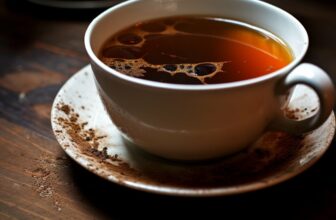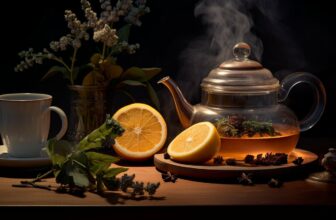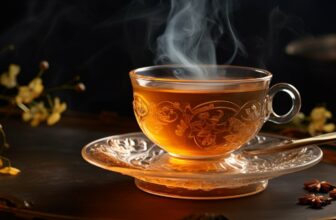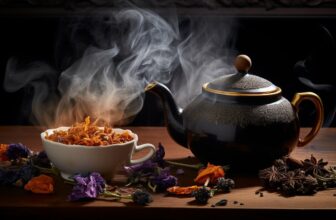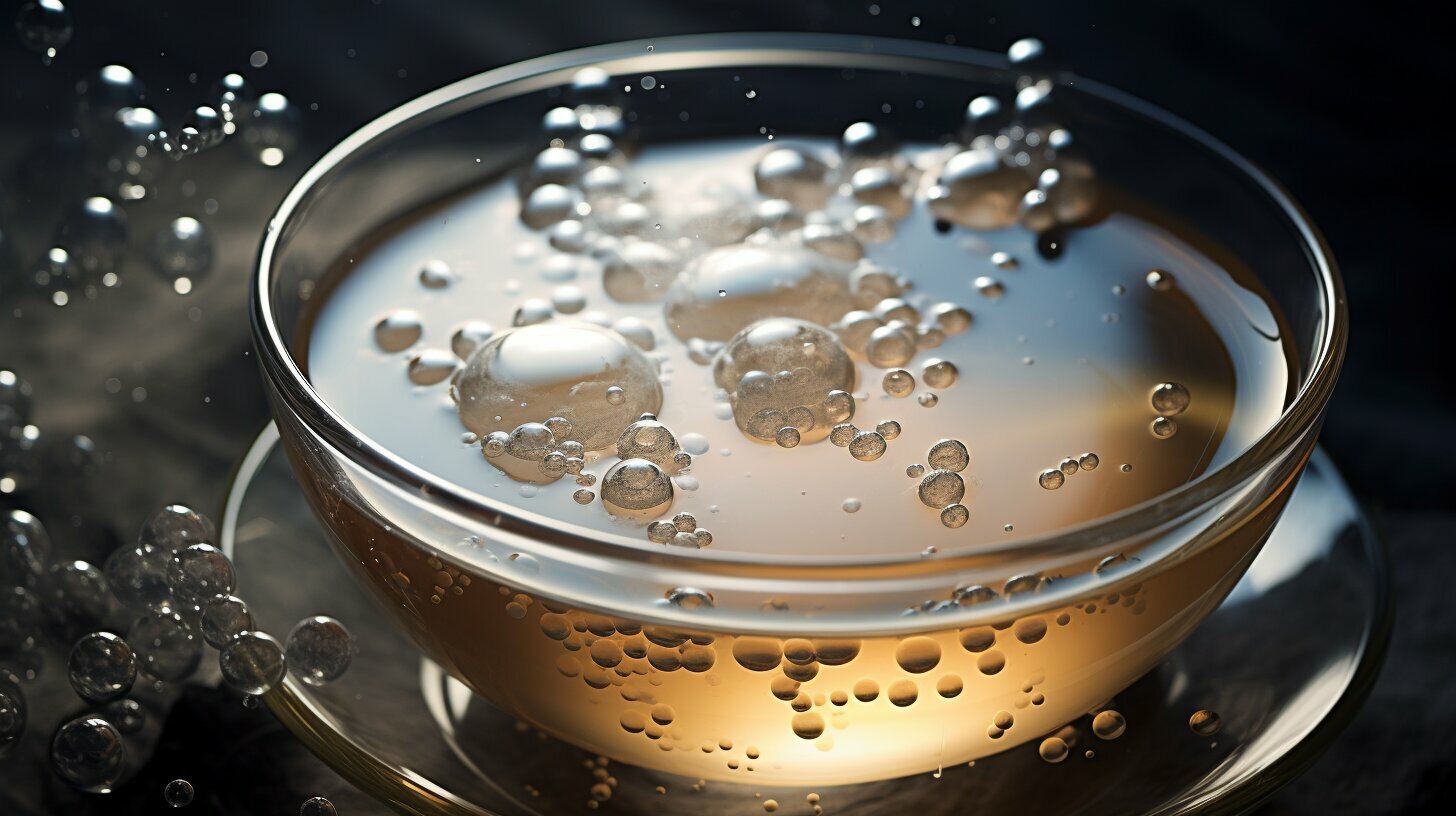
Some tea drinkers have experienced a strange soapy taste when drinking Earl Grey tea. This can be attributed to various factors, including oversteeping the tea, the specific ingredients used in Earl Grey tea, and changes in a person’s taste buds.
The Impact of Oversteeping
Oversteeping tea can result in a higher concentration of compounds that contribute to a soapy taste. Adjusting brewing parameters can help avoid a soapy taste.
The Role of Earl Grey Tea
Earl Grey tea is a common culprit for a soapy taste. The Crush-Tear-Curl method and the addition of bergamot oil can enhance the soapy flavor.
Changes in Taste Perception
Sickness, pregnancy, and changes in taste buds can affect taste perception, leading to a soapy flavor in tea.
Conclusion
To avoid the soapy taste in Earl Grey tea, it is important to pay attention to brewing parameters and use high-quality tea leaves. Understanding changes in taste perception can also help prevent a soapy flavor.
Key Takeaways:
- The soapy taste in Earl Grey tea can be caused by oversteeping, specific ingredients, and changes in taste buds.
- Adjusting brewing parameters can help avoid a soapy taste.
- The Crush-Tear-Curl method and bergamot oil can contribute to the soapy flavor in Earl Grey tea.
- Sickness, pregnancy, and changes in taste buds can affect taste perception and lead to a soapy flavor.
- Using high-quality tea leaves and understanding changes in taste perception can help prevent a soapy taste in Earl Grey tea.
The Impact of Oversteeping
Oversteeping tea can have a significant impact on the taste, leading to a bitter and even soapy flavor. When tea is steeped for too long, the concentration of certain compounds, including those that taste bitter, increases. This correlation between bitterness and a soapy flavor is what causes the unpleasant taste in oversteeped tea.
Several brewing parameters can influence the concentration of compounds in brewed tea, including the amount of tea leaves used, the size and insulation of the brewing vessel, water temperature, and steeping time. Adjusting these parameters can help prevent oversteeping and avoid a soapy taste. For example, using fewer tea leaves or decreasing the steeping time can reduce the concentration of bitter compounds and improve the overall flavor.
To determine the optimal brewing parameters for your personal taste preference, it may require some experimentation. However, as a general guideline, it is recommended to use around 2 grams of tea leaves per 8-ounce cup of water and steep for 3-4 minutes at a water temperature of around 176-185°F (80-85°C).
Understanding the Impact of Oversteeping
Oversteeping tea not only affects the taste but can also result in the release of unwanted compounds that contribute to a soapy flavor. By being mindful of brewing parameters and avoiding extended steeping times, tea enthusiasts can ensure a better, more enjoyable cup of tea.
The Role of Earl Grey Tea
Earl Grey tea is a popular beverage known for its distinct flavor. However, it is also one of the main culprits for the soapy taste that some tea drinkers experience. The specific ingredients and production methods used in Earl Grey tea contribute to this unique flavor profile. Understanding the role of Earl Grey tea can help shed light on why it can sometimes taste like soap.
Many mass-market brands produce Earl Grey tea using the Crush-Tear-Curl (CTC) method. This method involves breaking the tea leaves into small pieces, which increases the surface area and allows for a quick infusion of flavor. However, it also leads to the quick dissolution of bitter compounds, including tannins, that can enhance the soapy flavor. Additionally, bergamot oil, a key ingredient in Earl Grey tea, is responsible for its distinctive taste. While bergamot oil adds a citrusy note to the tea, it can also contribute to the soapy flavor if not properly balanced.
Furthermore, the quality of the tea leaves used in Earl Grey tea can also impact its taste. Low-quality tea leaves, often used in tea bags, may contain more bitter compounds and impurities that can contribute to a bitter and soapy taste. Opting for high-quality tea leaves, such as loose-leaf Earl Grey tea, can help ensure a more enjoyable and flavorful tea-drinking experience.
| Key Factors | Impact on Taste |
|---|---|
| Crush-Tear-Curl Method | Quick infusion and dissolution of bitter compounds, enhancing the soapy flavor |
| Bergamot Oil | Distinctive flavor, but improper balance can contribute to the soapy taste |
| Quality of Tea Leaves | Low-quality leaves may contain more bitter compounds, leading to a bitter and soapy taste |
By understanding these factors, tea drinkers can make informed choices when selecting and brewing Earl Grey tea, helping to avoid or minimize the soapy taste and enjoy the true essence of this beloved beverage.
Changes in Taste Perception
Changes in taste perception can have a significant impact on the flavors we perceive in food and beverages, including tea. Various factors can influence taste perception, such as sickness, pregnancy, and a blocked nose. When we are sick or have a blocked nose, our ability to taste and smell is diminished, resulting in changes in the way we perceive flavors. This can lead to a soapy taste in certain foods and beverages, including Earl Grey tea.
Pregnancy is another factor that can affect taste perception. Hormonal changes during pregnancy can alter a person’s sense of taste, causing certain flavors to become more pronounced or less enjoyable. This can contribute to a soapy flavor in Earl Grey tea for some pregnant individuals.
It’s also important to note that taste buds can change as we age. What once tasted good to us may no longer be enjoyable due to changes in our taste buds. This can also contribute to a soapy flavor in tea, as our taste buds may perceive certain compounds differently over time.
Overall, understanding the impact of changes in taste perception is crucial in explaining why tea, specifically Earl Grey tea, may taste different, including a soapy flavor. By recognizing these factors, individuals can better understand and navigate their taste preferences, and make informed decisions about their tea choices.
Effect on Taste and Smell
Sickness, pregnancy, and a blocked nose can all have a profound effect on our ability to taste and smell. When we are sick, our taste buds may become dulled, causing flavors to be less pronounced or even altered. Similarly, a blocked nose can impair our sense of smell, which is closely linked to our ability to taste. Without a fully functioning sense of smell, flavors may seem muted or distorted.
During pregnancy, hormonal changes can heighten our sense of taste and smell, making certain flavors more intense. This can result in a heightened sensitivity to the compounds found in Earl Grey tea, potentially leading to a soapy taste.
Final Thoughts
Changes in taste perception are a natural part of life and can have a significant impact on the way we experience flavors, including those in tea. Understanding the influence of factors such as sickness, pregnancy, and aging can help tea drinkers better navigate their taste preferences and avoid a soapy flavor in Earl Grey tea. By being mindful of these factors and experimenting with brewing parameters, individuals can continue to enjoy a delicious cup of tea without any unwanted tastes.
Conclusion
To avoid the soapy taste in Earl Grey tea, it is essential to pay attention to the brewing parameters. Start by using optimal brewing parameters such as the right amount of tea leaves, the appropriate size of the brewing vessel, the correct water temperature, and the ideal steeping time. Adjusting these factors can significantly impact the taste of your tea and help you avoid that unwanted soapy flavor.
Another crucial aspect to consider is the quality of tea leaves you use. Opt for high-quality tea leaves instead of low-quality ones found in tea bags. High-quality tea leaves tend to have a more balanced flavor profile and are less likely to result in a bitter and soapy taste.
By being mindful of these brewing parameters and opting for high-quality tea leaves, you can enjoy a delicious cup of Earl Grey tea without any soapy flavor. Remember, it’s all about finding the perfect balance to experience the full-bodied and aromatic qualities that make Earl Grey tea so beloved.
FAQ
Why does Earl Grey tea taste like soap?
The soapy taste in Earl Grey tea can be attributed to factors such as oversteeping the tea, the specific ingredients used in Earl Grey tea like bergamot oil, and changes in a person’s taste buds.
What causes the soapy flavor in tea?
Oversteeping tea can result in a higher concentration of compounds that contribute to a soapy taste. Certain ingredients like bergamot oil, commonly found in Earl Grey tea, can also contribute to the soapy flavor.
Why does Earl Grey tea have a bitter taste?
Earl Grey tea can have a bitter taste due to the Crush-Tear-Curl (CTC) method used in its production, which increases the surface area of the tea leaves, allowing for quick infusion. This method can lead to the quick dissolution of bitter compounds like tannins.
Can changes in taste perception affect how tea tastes?
Yes, changes in taste perception due to factors like sickness, pregnancy, and a blocked nose can affect how tea tastes. When a person’s sense of taste and smell is diminished, flavors may be perceived differently, including a soapy taste in tea.
How can I avoid the soapy taste in Earl Grey tea?
To avoid the soapy taste in Earl Grey tea, pay attention to brewing parameters such as the amount of tea leaves, brewing vessel size, water temperature, and steeping time. Using high-quality tea leaves and avoiding the Crush-Tear-Curl method can also help prevent a bitter and soapy taste.



